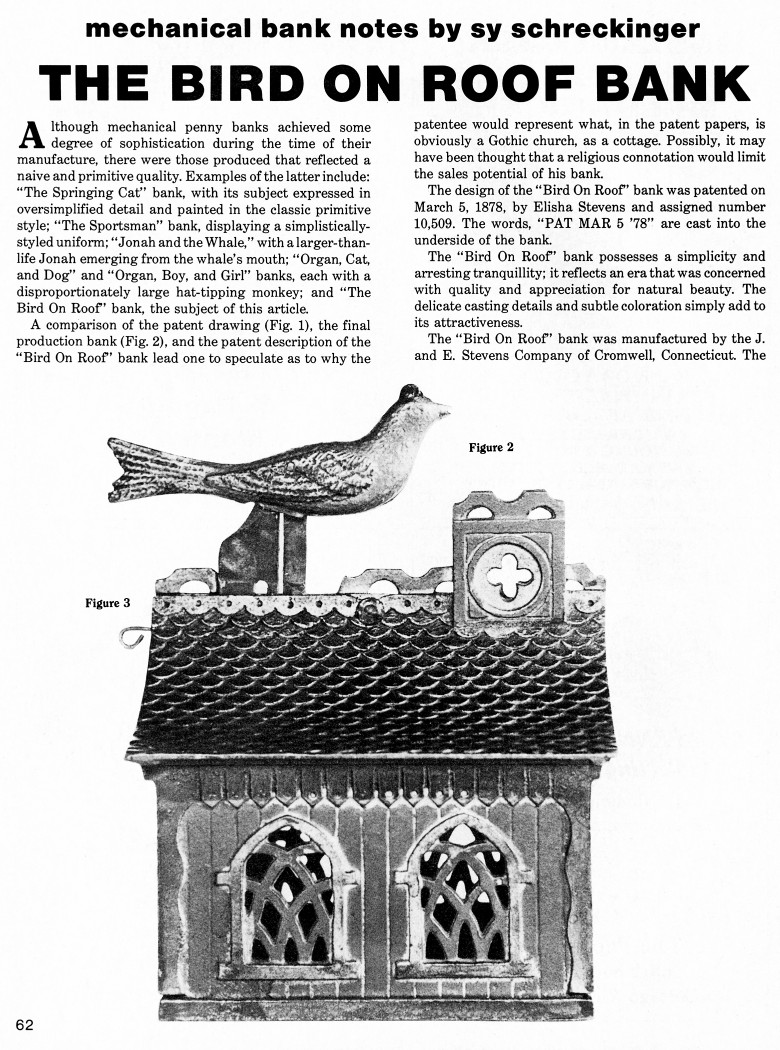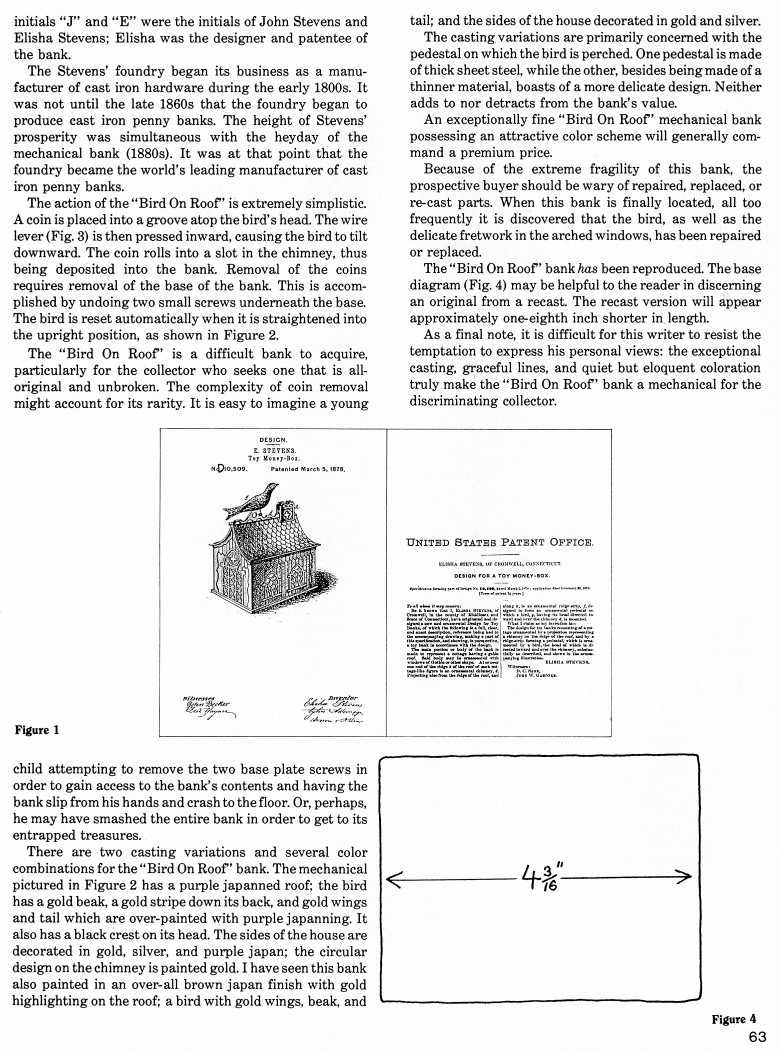|
The Bird on Roof Bank
by Sy Schreckinger – ANTIQUE TOY WORLD Magazine – December,
1984
Although mechanical penny banks
achieved some degree of sophistication during the time of their
manufacture, there were those produced that reflected a naive and
primitive quality. Examples of the latter include: "The Springing Cat"
bank, with its subject expressed in oversimplified detail and painted in
the classic primitive style; "The Sportsman" bank, displaying a
simplistically-styled uniform; "Jonah and the Whale," with a larger-than
life Jonah emerging from the whale's mouth; "Organ, Cat, and Dog" and
"Organ, Boy, and Girl" banks, each with a disproportionately large
hat-tipping monkey; and "The Bird On Roof" bank, the subject of this
article.
A comparison of the patent drawing (Fig. 1), the final production
bank (Fig. 2), and the patent description of the "Bird On Roof" bank lead
one to speculate as to why the patentee would represent what, in the
patent papers, is obviously a Gothic church, as a cottage. Possibly, it
may have been thought that a religious connotation would limit the sales
potential of his bank.
The design of the "Bird On Roof" bank was patented on March 5, 1878,
by Elisha Stevens and assigned number
10,509. The words, "PAT MAR 5 '78"
are cast into the underside of the bank.
The "Bird On Roof" bank possesses a simplicity and arresting
tranquility; it reflects an era that was concerned with quality and
appreciation for natural beauty. The delicate casting details and subtle
coloration simply add to its attractiveness.
The "Bird On Roof" bank was manufactured by the J. and E. Stevens
Company of Cromwell, Connecticut. The initials "J" and "E" were the
initials of John Stevens and Elisha Stevens; Elisha was the designer and
patentee of the bank.
The Stevens' foundry began its business as a manufacturer of cast
iron hardware during the early 1800s. It was not until the late 1860s that
the foundry began to produce cast iron penny banks. The height of Stevens'
prosperity was simultaneous with the heyday of the mechanical bank
(1880s). It was at that point that the foundry became the world's leading
manufacturer of cast iron penny banks.
The action of the "Bird On Roof" is extremely simplistic. A coin is
placed into a groove atop the bird's head. The wire lever (Fig. 3) is then
pressed inward, causing the bird to tilt downward. The coin rolls into a
slot in the chimney, thus being deposited into the bank. Removal of the
coins requires removal of the base of the bank. This is accomplished by
undoing two small screws underneath the base. The bird is reset
automatically when it is straightened into the upright position, as shown
in Figure 2.
The "Bird On Roof" is a difficult bank to acquire, particularly for
the collector who seeks one that is all-original and unbroken. The
complexity of coin removal might account for its rarity. It is easy to
imagine a young child attempting to remove the two base plate screws in
order to gain access to the bank's contents and having the bank slip from
his hands and crash to the floor. Or, perhaps, he may have smashed the
entire bank in order to get to its entrapped treasures.
There are two casting variations and several color combinations for
the "Bird On Roof" bank. The mechanical pictured in Figure 2 has a purple
japanned roof; the bird has a gold beak, a gold stripe down its back, and
gold wings and tail which are over-painted with purple japanning. It also
has a black crest on its head. The sides of the house are decorated in
gold, silver, and purple japan; the circular design on the chimney is
painted gold. I have seen this bank also painted in an overall brown japan finish with gold highlighting on the roof; a bird with gold wings,
beak, and tail; and the sides of the house decorated in gold and silver.
The casting variations are primarily concerned with the pedestal on which
the bird is perched. One pedestal is made of thick sheet steel, while the
other, besides being made of a thinner material, boasts of a more delicate
design. Neither adds to nor detracts from the bank's value.
An exceptionally fine "Bird On Roof" mechanical bank possessing an
attractive color scheme will generally command a premium price.
Because of the extreme fragility of this bank, the prospective buyer
should be wary of repaired, replaced, or re-cast parts. When this bank is
finally located, all too frequently it is discovered that the bird, as
well as the delicate fretwork in the arched windows, has been repaired or
replaced.
The "Bird On Roof" bank has been reproduced. The base diagram (Fig.
4) may be helpful to the reader in discerning an original from a recast.
The recast version will appear approximately one-eighth inch shorter in
length.
As a final note, it is difficult for this writer to resist the
temptation to express his personal views: the exceptional casting,
graceful lines, and quiet but eloquent coloration truly make the "Bird On
Roof" bank a mechanical for the discriminating collector.
|


